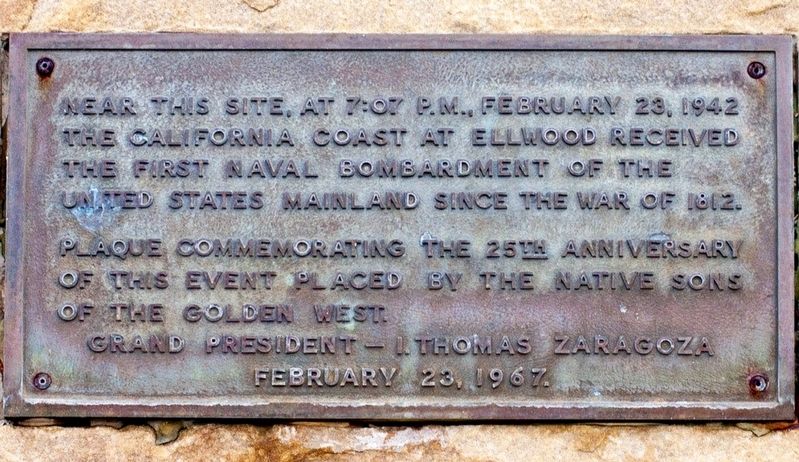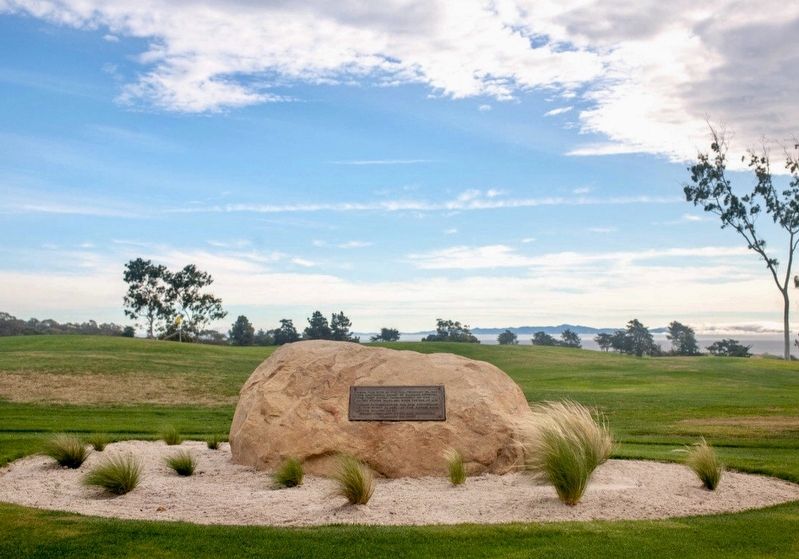Goleta in Santa Barbara County, California — The American West (Pacific Coastal)
Japanese Attack
Erected 1967 by Native Sons of the Golden West.
Topics and series. This memorial is listed in this topic list: War, World II. In addition, it is included in the Native Sons/Daughters of the Golden West series list. A significant historical date for this entry is February 23, 1942.
Location. 34° 25.826′ N, 119° 54.439′ W. Marker is in Goleta, California, in Santa Barbara County. Memorial can be reached from Hollister Avenue west of Cathedral Oaks Road, on the left when traveling west. At the Sandpiper Golf Club, south of the clubhouse. Touch for map. Marker is at or near this postal address: 7925 Hollister Ave, Goleta CA 93117, United States of America. Touch for directions.
Other nearby markers. At least 8 other markers are within 8 miles of this marker, measured as the crow flies. A different marker also named Japanese Attack (approx. half a mile away); Goleta Depot (approx. 3.2 miles away); Earle Ovington Terminal (approx. 4.1 miles away); Ovington's Hangar (approx. 4.7 miles away); Cold Spring Tavern (approx. 7.4 miles away); Old Stagecoach Route (approx. 7.7 miles away); Hope House (approx. 7.8 miles away); Cold Spring Arch Bridge (approx. 8 miles away). Touch for a list and map of all markers in Goleta.
Regarding Japanese Attack. The Japanese government ordered a submarine to shell the California coast during President Roosevelt's weekly radio speech. Captain Kozo Nishino was a naval reserve officer who, before the war, had commanded a merchant ship that stopped at Ellwood Oil Field to take on a cargo of oil. His attack damaged a derrick, pump house, pier, and catwalk. After 20 minutes, the gunners ceased fire and the submarine sailed away. Even though he caused only minor damage, Nishino had achieved his purpose, which was to spread fear along the American west coast.
Oil production at this site ended in 1965, and the golf club was developed in 1972.
Also see . . .
1. The Shelling of Ellwood (militarymuseum.org). (Submitted on September 6, 2019.)
2. Japanese Sub attacks Oilfield (American Oil and Gas Historical Society). (Submitted on September 6, 2019.)
Credits. This page was last revised on April 2, 2024. It was originally submitted on September 1, 2019, by Craig Baker of Sylmar, California. This page has been viewed 622 times since then and 54 times this year. It was the Marker of the Week February 21, 2021. Photos: 1, 2. submitted on September 1, 2019, by Craig Baker of Sylmar, California. • Andrew Ruppenstein was the editor who published this page.

